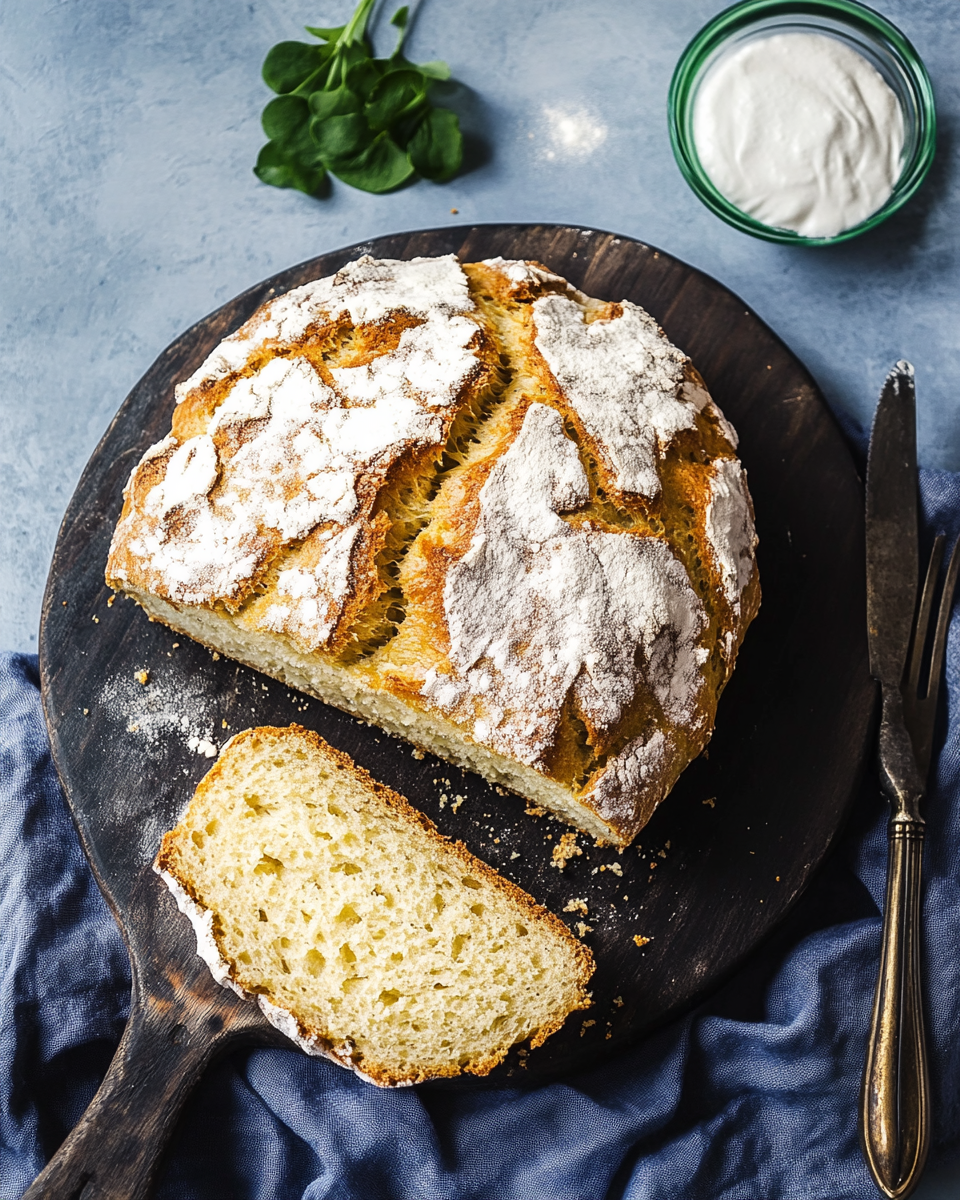Irish Soda Bread is a time-honored staple in Irish households, cherished for its simplicity and hearty nature. Made without yeast, this quick bread relies on the reaction between baking soda and buttermilk to achieve its rise, resulting in a dense yet tender crumb encased in a crisp crust. Traditionally baked to accompany meals, this bread’s subtle tang and rustic texture make it versatile for both sweet and savory pairings. Whether enjoyed plain, with a spread of butter, or alongside a warm stew, Irish Soda Bread brings a touch of wholesome comfort to any table.
Full recipe:
Ingredients:
- 4 cups all-purpose flour
- 1 teaspoon baking soda
- 1 teaspoon salt
- 1 ¾ cups buttermilk
Directions:
- Preheat your oven to 425°F (218°C). Line a baking sheet with parchment paper.
- In a large bowl, whisk together the flour, baking soda, and salt until well combined.
- Make a well in the center of the dry ingredients and pour in the buttermilk. Using a wooden spoon or your hands, mix until a soft dough forms.
- Turn the dough out onto a lightly floured surface and gently knead for about 1 minute, just until it comes together. Do not over-knead.
- Shape the dough into a round loaf and place it on the prepared baking sheet. Using a sharp knife, score a deep “X” on top of the loaf.
- Bake for 30-35 minutes, or until the bread is golden brown and sounds hollow when tapped on the bottom.
- Remove from the oven and let cool on a wire rack before slicing.
Prep Time: 10 minutes | Cooking Time: 35 minutes | Total Time: 45 minutes
Calories: 180 kcal per serving | Servings: 8
Traditional Irish Soda Bread – A Timeless Classic
Introduction to Irish Soda Bread
Irish Soda Bread is one of Ireland’s most beloved and recognizable foods. This simple yet flavorful bread has been a staple in Irish households for centuries. Unlike yeast-based bread, Irish Soda Bread relies on a quick chemical reaction between baking soda and buttermilk to achieve its rise, making it an ideal choice for those who want fresh, homemade bread without long proofing times.
With a rustic appearance, golden-brown crust, and a soft yet dense interior, this bread is not only easy to make but also incredibly versatile. Whether enjoyed plain, slathered with butter, or paired with a hearty Irish stew, its comforting texture and subtle tang make it a favorite across generations.
The History of Irish Soda Bread
Irish Soda Bread dates back to the early 19th century when baking soda (also known as sodium bicarbonate) became widely available in Ireland. Before this, yeast was the primary leavening agent, which required longer fermentation times and could be unreliable.
Since Ireland’s climate made wheat farming difficult, most people used soft wheat flour, which doesn’t work well with yeast but is perfect for soda-based bread. The combination of baking soda, buttermilk, flour, and salt created a bread that was not only quick and easy to make but also inexpensive and filling, making it a staple in many Irish homes.
Traditionally, Irish Soda Bread was baked in a cast-iron pot (a bastible) over an open fire, giving it a thick crust and an earthy, hearty texture. Today, ovens have replaced open fires, but the essence of the recipe remains unchanged.
The signature cross cut into the top of the loaf has both practical and symbolic purposes. Practically, it allows heat to distribute evenly during baking. Symbolically, Irish folklore suggests that the cross warded off evil spirits and protected the household.
Why Irish Soda Bread is Special
1. Quick and Easy to Make
Irish Soda Bread requires only four basic ingredients: flour, baking soda, salt, and buttermilk. It does not require yeast, making it a no-fuss, no-knead bread that can be prepared in under an hour.
2. No Special Equipment Needed
Unlike many bread recipes that require stand mixers, proofing baskets, or long rising times, Irish Soda Bread is incredibly simple. All you need is a mixing bowl, a baking sheet, and an oven.
3. Healthy and Nutritious
This bread is made from simple, wholesome ingredients. Traditional Irish Soda Bread is:
- Low in fat – No butter or oil is added to the dough.
- Rich in calcium – Buttermilk provides a good dose of calcium and protein.
- Easy to digest – The baking soda and buttermilk work together to create a soft texture that’s gentle on the stomach.
- No preservatives or additives – Unlike store-bought bread, homemade soda bread is free from artificial ingredients.
4. A Versatile Recipe
While the traditional version is made with just four ingredients, you can modify this bread to suit your taste. Some variations include:
- Whole Wheat Irish Soda Bread – For a more fiber-rich version, substitute some or all of the flour with whole wheat flour.
- Sweet Irish Soda Bread – Add raisins, currants, or a touch of honey for a slightly sweet version.
- Savory Soda Bread – Mix in herbs like rosemary, thyme, or even cheddar cheese for a flavorful twist.
How to Make the Perfect Irish Soda Bread
Ingredients:
- 4 cups all-purpose flour
- 1 teaspoon baking soda
- 1 teaspoon salt
- 1 ¾ cups buttermilk
Instructions:
- Preheat oven to 425°F (218°C) and line a baking sheet with parchment paper.
- Combine the dry ingredients – In a large mixing bowl, whisk together the flour, baking soda, and salt.
- Add the buttermilk – Make a well in the center and pour in the buttermilk. Use a spoon or your hands to mix until a soft dough forms.
- Knead lightly – Turn the dough onto a lightly floured surface and knead just enough to bring it together (about 1 minute). Do not overwork it.
- Shape and score – Form the dough into a round loaf and place it on the baking sheet. Use a sharp knife to cut a deep “X” on the top.
- Bake – Place in the oven and bake for 30-35 minutes until golden brown.
- Cool and serve – Let the bread cool for at least 10 minutes before slicing.
Serving Suggestions
Irish Soda Bread is incredibly versatile and can be served in various ways:
- With Butter and Jam – Enjoy a warm slice with Irish butter and homemade jam.
- Alongside Soups and Stews – This bread is perfect for dipping into a rich Irish stew or potato soup.
- With Cheese and Cold Cuts – Pair it with cheese, ham, or smoked salmon for a traditional Irish snack.
- Toasted with Honey – Lightly toast a slice and drizzle it with honey for a sweet treat.
Common Mistakes and How to Avoid Them
1. Over-Kneading the Dough
Irish Soda Bread dough should not be kneaded like traditional bread. Overworking the dough can make it tough and dense rather than light and fluffy.
2. Not Scoring the Bread
The cross on top isn’t just decorative! If you don’t score the top, the bread may bake unevenly and crack unpredictably.
3. Using Regular Milk Instead of Buttermilk
Buttermilk is essential because it reacts with baking soda to create the bread’s rise. If you don’t have buttermilk, you can make a substitute by mixing 1 ¾ cups of milk with 1 tablespoon of vinegar or lemon juice.
4. Using Too Much or Too Little Flour
Always measure your flour correctly by scooping it lightly into the measuring cup and leveling it off with a knife. Too much flour makes the bread dry, while too little flour makes it too sticky.
Why You Should Try This Recipe
Perfect for beginners – If you’ve never baked bread before, this is a great place to start!
Takes less than an hour – From start to finish, you can have warm, fresh bread in under 45 minutes.
Affordable and pantry-friendly – Uses simple ingredients you probably already have.
Tastes amazing with anything – Whether sweet or savory, Irish Soda Bread is always a winner.
Conclusion
Traditional Irish Soda Bread is more than just a recipe—it’s a piece of Irish heritage. Whether you’re celebrating St. Patrick’s Day or simply craving a quick and hearty loaf, this bread is the perfect addition to any meal. With its simple ingredients, easy preparation, and deliciously rustic taste, it’s no wonder this bread has been a favorite for centuries. Try it today, and bring a touch of Irish tradition into your home!






